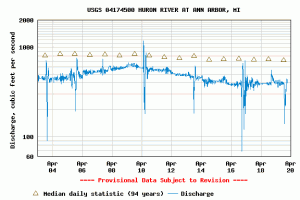
With the huge rain last week and the flood warnings, I visited the U.S. Geologic Survey’s (USGS) real-time stream flow gages on the river to see how the river reacted . In the Huron, we have 4 permanent USGS gages in the river that measure stream flow constantly. The sites are the Huron River near New Hudson, the Huron River near Hamburg, Mill Creek in Dexter, and Wall Street in Ann Arbor. These gages allow us to see how the river responds to rain and snowmelt. A slow, gradual rate of stream flow increase (and corresponding decrease) is indicative of a more natural and higher quality river with natural areas for infiltration. An erratic rate of increase (and decrease) is indicative of a more impacted and degraded river where pavement and pipes prevail.
The USGS also has a map of real-time streamflow compared to historical streamflow for the day of the year for Michigan. Only one of the sites on the Huron, that farthest up on the system, is “normal”, two other sites being “above normal” and the stream flow at Wall St. in Ann Arbor is “much above normal”. Normal flow patterns change due to increased impervious surfaces such as roads and rooftops, a loss of natural areas such as wetlands, floodplains, and forests, and dams that alter the natural flow of the river. There may also be a regional variation in annual rain amounts.
In this and coming decades, meteorologists project more intense storms for Michigan, warming and cooling periods in close succession, and an overall warming trend. HRWC is working hard to restore the river and creeks to a more natural and healthy system so they can respond to the “weird” weather–taking up and storing more rain water in storms, slowly releasing the water in to the groundwater, creeks, and rivers over time to keep steady flows in drier weather–overall, allowing for a more dynamic system to respond to the extreme weather. Examples of this kind of work include the recent protection of 40 acres of wetland in the watershed and in cumulative over 6,000 acres in Washtenaw County, the removal of Mill Pond Dam in Dexter, buffer ordinances passed in 4 watershed communities in the last 4 years, the installation of over 1300 rainbarrels and 2 dozen rain gardens, and much more.
Without funding from the USGS and local government partners to maintain these gages, it would be far more difficult to “read” the river through stream flows. Unfortunately, the gage in Milford was discontinued in the past year due to tight budgets. More, not fewer, gages are what we need on the river.
Please join us in building resilient communities and watershed. Visit our website at hrwc.org.



